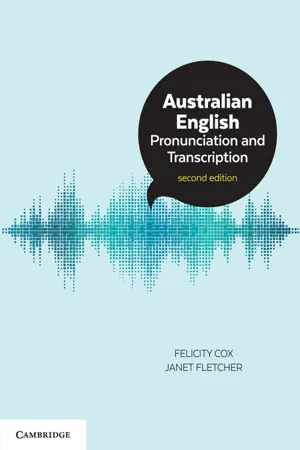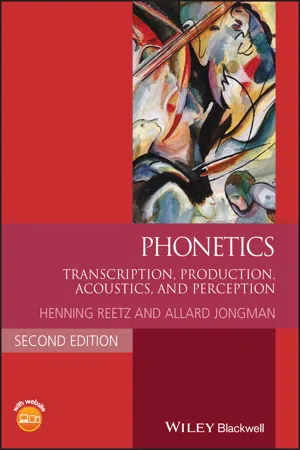Languages & Linguistics
Bilabial
Bilabial refers to a speech sound produced by bringing both lips together. In phonetics, bilabial sounds are classified as consonants, such as /p/ and /b/, and are characterized by the articulation of the lips. These sounds are common in many languages and are considered one of the basic articulatory features in the study of speech sounds.
Written by Perlego with AI-assistance
4 Key excerpts on "Bilabial"
- Victoria Fromkin, Robert Rodman, Nina Hyams, , Victoria Fromkin, Robert Rodman, Nina Hyams(Authors)
- 2018(Publication Date)
- Cengage Learning EMEA(Publisher)
Labials [p] [b] [m] [f] [v] [w] [ʍ] Labial sounds are those articu- lated with the involvement of the lips. They include the class of Bilabial sounds [p], [b], and [m], the labiodentals [f] and [v], and the labiovelars [w] and [ʍ]. Coronals [u] [ð] [t] [d] [n] [s] [z] [ʃ] [ʒ] [ʧ] [ʤ] [l] [r] Coronal sounds are articulated by raising the tongue blade. Coronals include the inter- dentals [u] and [ð], the alveolars [t], [d], [n], [s], and [z], the palatals [ʃ] and [ʒ], the affricates [ʧ] and [ʤ], and the liquids [l] and [r]. Copyright 2019 Cengage Learning. All Rights Reserved. May not be copied, scanned, or duplicated, in whole or in part. Due to electronic rights, some third party content may be suppressed from the eBook and/or eChapter(s). Editorial review has deemed that any suppressed content does not materially affect the overall learning experience. Cengage Learning reserves the right to remove additional content at any time if subsequent rights restrictions require it. 204 CHAPTER 5 Phonetics: The Sounds of Language Anteriors [p] [b] [m] [f] [v] [u] [ð] [t] [d] [n] [s] [z] Anterior sounds are consonants produced in the front part of the mouth, that is, from the alveolar area forward. They include the labials, the interdentals, and the alveolars. Sibilants [s] [z] [ʃ] [ʒ] [ʧ] [ʤ] This class of consonantal sounds is char- acterized by an acoustic rather than an articulatory property of its members. The friction created by sibilants produces a hissing sound, which is a mixture of high-frequency sounds. Syllabic Sounds Sounds that may function as the core of a syllable possess the feature syllabic. Clearly vowels are syllabic, but they are not the only sound class that anchors syllables. Liquids and nasals may also be syllabic, as shown by the words dazzle [dæzl̩], faker [fekr̩], rhythm [rɪðm̩ ], and wagon [wægn̩].- Felicity Cox, Janet Fletcher(Authors)
- 2017(Publication Date)
- Cambridge University Press(Publisher)
Familiarity with the full set of IPA symbols allows us to represent not only English and its various allo- phones but also foreign languages, foreign-accented speech, developmental speech and atypical disordered productions. The full IPA chart can be found at the back of this book. For transcribing disordered speech production there is an extension to the IPA. See the IPA website for details. Bilabial Bilabial articulations involve the upper and lower lip. For example, /p, b, m/ are initial sounds in paw, bore and more. Figures 2.5 and 2.6 illustrate the Bilabial place of articulation for oral and nasal Bilabial consonants respect- ively. Notice that in Figure 2.5 the soft palate is raised for oral articulations such as /p, b/ so that the passage of airflow is through the mouth, whereas in Figure 2.6 the soft palate is lowered to allow air to flow into the nose for nasal articulations such as /m/. Labiodental In labiodental articulations the lower lip articulates with the tips of the upper front teeth. For example, /f, v/ are the initial sounds in for and vow. Figure 2.7 illustrates the labiodental place of articulation with the soft palate raised to allow the airflow to be directed through the mouth. The labioden- tal nasal [ɱ] is an allophone of /m/ in AusE and occurs in words like triumph. For this sound the soft palate is lowered. Dental For dental sounds the tip or blade of the tongue articulates with the upper front teeth. For example, /θ, ð/ are the initial sounds in thaw and though. 34 Australian English Pronunciation and Transcription Figure 2.6 Schematic showing Bilabial place of articulation with the soft palate lowered for nasal consonants such as /m/ . . . . . . . . . . . . . . . . . . . . . . . . . . . . . . . . . . . . . . . . . . . . . . . . . . . . . . . . . . . . . . . . . . . . . . . . . . . . . . . . . .- eBook - ePub
- Bruce M. Rowe, Diane P. Levine(Authors)
- 2022(Publication Date)
- Routledge(Publisher)
Articulation is the production of speech sounds by the movement of the speech organs. We have noted that once out of the glottis, the airstream may or may not be obstructed in the cavity above the glottis. If it is not obstructed, we have a vowel; if it is obstructed, then we have a consonant. The following paragraphs list some of the “landmark” areas used in English to differentiate sound based on the place of articulation. We use the word “landmark” because various sounds can usually be produced in more than one way. The exact place of articulation for a specific sound will vary from person to person and even from time to time for an individual. Furthermore, sounds that we perceive as being the same often are not the same in acoustic terms. In the listing of places of articulation, English consonants are used as examples. Speakers of other languages may form sounds at articulatory locations not used in English.Articulation is the production of speech sounds by the movement of the speech organs.Bilabials are produced by bringing the lips together. This place of articulation can easily be illustrated by noting the position of the lips for the initial sounds in such words as pool, boot and money. These sounds are phonetically represented by [p], [b], and [m], respectively.Labiodentals, the initial sounds in five, fine, vim, and vine, are produced by raising the lower lip until it comes near the upper front teeth. The three Bilabials, [p], [b], and [m], and the two labiodentals, [f] and [v], are sometimes grouped together under the general designation of labials.Dentals are articulated by the tongue and teeth, in contrast to the labiodentals, which involve the articulation of the lower lip and teeth. The two dentals in English are found in the initial sounds in think and then. When you make one of these th sounds, your tongue may go either between the top and bottom teeth or behind the top front teeth. Because both ways are the usual place for producing these sounds, the term dental would seem better than the alternative term, interdental, sometimes used to describe the th sounds. Interdental - eBook - PDF
Phonetics
Transcription, Production, Acoustics, and Perception
- Henning Reetz, Allard Jongman(Authors)
- 2020(Publication Date)
- Wiley-Blackwell(Publisher)
Sounds produced in this way are called glottal sounds . Articulatory Phonetics 13 The articulators forming the lower surface of the vocal tract include: 1. Lower lip, which can actively approximate or touch the upper lip or the upper teeth, resulting in Bilabial or labiodental sounds, respectively. 2. Lower teeth, which take part in the production of certain dental sounds. Most important, however, is the tongue, the muscle that is attached to the lower jaw (mandible). The tongue can be divided into the following six regions (3-8), going from front to back: 3. Tongue tip . This is the frontmost part of the tongue. Sounds produced with the tongue tip (apex of the tongue) are known as apical sounds. 4. Tongue blade . This is a short section following the tip. It is below the alveolar ridge when the vocal tract is in its neutral or rest position. Sounds produced with the tongue blade (lamen) are known as laminal sounds. 5. Front of the tongue body . This is the front part of the tongue body so it is actually more the middle portion of the tongue . It is that part of the tongue that is below the palate when the tongue is in its rest position. 6. Center of the tongue body. This middle part of the tongue body is roughly beneath the palate and the velum at rest position. 7. Back of the tongue body. This rear portion of the tongue body is the part beneath the velum. It is also known as the tongue dorsum . 8. Tongue root . This is the part of the tongue opposite the back wall of the phar-ynx. Sounds produced with the root (radix) are referred to as radical sounds . 9. Epiglottis . It is a cartilaginous structure moving downward and backward with the tongue. As the tongue moves backward during swallowing, the epi-glottis folds down and covers the glottis, thus channeling food and fluids to the esophagus. There is some debate about the status of the epiglottis as an articulator.
Index pages curate the most relevant extracts from our library of academic textbooks. They’ve been created using an in-house natural language model (NLM), each adding context and meaning to key research topics.



